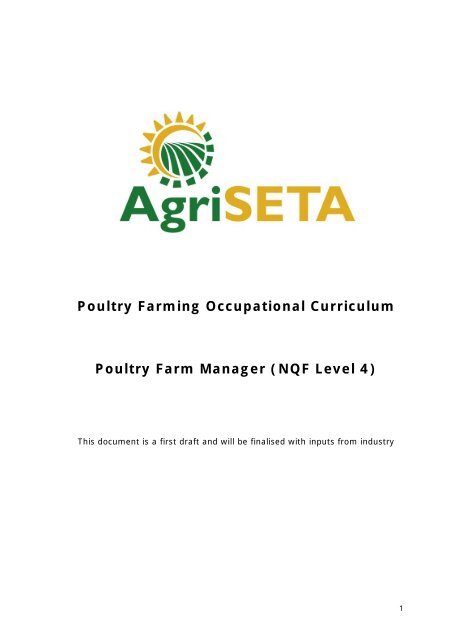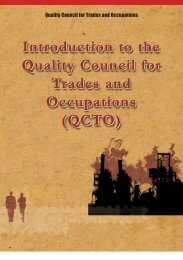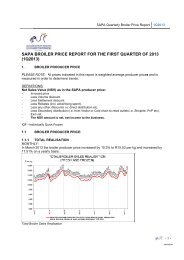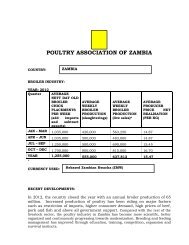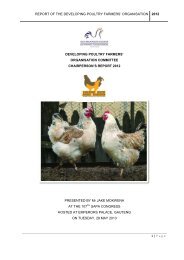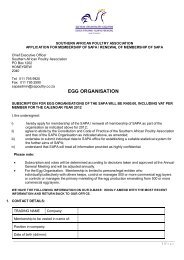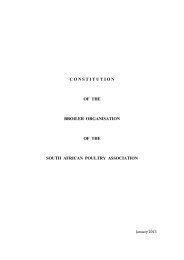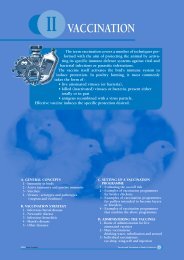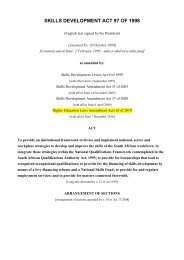Poultry Farm Manager - SAPA
Poultry Farm Manager - SAPA
Poultry Farm Manager - SAPA
- No tags were found...
Create successful ePaper yourself
Turn your PDF publications into a flip-book with our unique Google optimized e-Paper software.
TABLE OF CONTENTSSection 1: Curriculum Overview ..................................................................... 31. Occupational Information ........................................................................... 31.1 Occupational Cluster ............................................................................. 31.2 Occupational Field ................................................................................ 31.3 Related Occupation............................................................................... 32. Qualification Focus and Progression ............................................................. 32.1 Occupational Profile .............................................................................. 42.2 Purpose Statement ............................................................................... 42.3 Occupational Tasks ............................................................................... 43. Curriculum Structure ................................................................................. 54. Current Learning Programmes and/or Qualifications that will replaced by theOccupational Qualification ................................................................................ 65. Curriculum Requirements ........................................................................... 65.1 Educational Entry Requirements ............................................................. 65.2 Physical Entry Requirements .................................................................. 65.3 Legal Entry Requirements ..................................................................... 6Section 2: Curriculum Components ................................................................ 71. Subject Specifications ................................................................................ 71.1 Operations Management (040105) ......................................................... 71.2 <strong>Poultry</strong> Production .............................................................................. 132. Practical Skills Modules ............................................................................ 192.1 Plan, direct and control people, costs and production resources ............... 192.2 Plan and control the utilisation, maintenance and physical bio-security status222.3 Achieve production targets and quality standards ................................... 243. Work Experience Modules......................................................................... 273.1 People, stock on hand and costs are managed ....................................... 273.2 Production site is fully operational ........................................................ 293.3 Production targets and quality standards achieved ................................. 302
Curriculum DocumentNr:612201Qualification Title:National Award: <strong>Poultry</strong> <strong>Farm</strong> <strong>Manager</strong> (NQF Level 4)Document Status Date VersionDraft 17/08/2011 2DevelopmentQualityPartnerName E-mail PhoneAgriSETA info@agriseta.co.za (012) 325 1655Section 1: Curriculum Overview1. Occupational Information1.1 Occupational ClusterTo be specified1.2 Occupational FieldTo be specified1.3 Related Occupation612201: <strong>Poultry</strong> <strong>Farm</strong> <strong>Manager</strong>2. Qualification Focus and ProgressionThe Occupational qualification for <strong>Poultry</strong> <strong>Farm</strong> <strong>Manager</strong>s prepares the learner for afirst line management role in a commercial farming unit as well as for personspracticing small scale poultry farming. The qualification is designed to address specificfirst line management functions and generic poultry farm management practices.Specific areas of contextual competence for specific poultry production systems, suchas layers, broilers and breeders will be addressed during the work experience orproduction experience components of the qualification. Specific contextualcomponents still requires further refinement and will be addressed during the pilotingphase of the curriculum design process. This approach promotes portability of thequalification within the various poultry production systems.Progression to higher levels of employment and associated career opportunities willnot require of the learner to achieve further formal occupational qualifications asprogression will depend on personal development in a poultry farming context.Access to higher level specialised operational management position in the formallabour market are however dependant on the learner achieving a qualification from theHigher Education Qualifications Framework. Should the learner meet the educationalrequirements for access to such qualifications, this qualification will assist the learnerwith a sound foundation in poultry farming related knowledge.A specific need for further learning in agricultural entrepreneurship is recognised forsmall scale poultry farmers and will be developed as a generic occupationalqualification.3
2.1 Occupational Profile2.2 Purpose Statement<strong>Poultry</strong> Production <strong>Manager</strong>: Manages resources, controls the achievement ofproduction targets and quality standards and the utilisation of the site.2.3 Occupational TasksOccupational Task 1: Managing people, stock on hand and costs of a poultryfarming operation (NQF Level:4)Unique Product or ServicePeople, stock on hand and costs are managedOccupational ResponsibilityManage the day to day aspects related to the labour force employed on a poultry farm,the production costs and stocks or materials required.Occupational ContextManage people, stock on hand and costs of a farming unit, reporting to operationalmanagement/the farmer.Occupational Task 2: Providing day to day direction and controlling poultryfarming operations to ensure that production targets and quality standardsare met (NQF Level 4)Unique Product or ServiceProduction targets and quality standards achievedOccupational ResponsibilityAchieve production targets and quality standards by overseeing and directing poultryproductionOccupational ContextManage and control poultry farming operations of a poultry production site, reportingto operational management, liaise with feed mills, consult professionals (veterinarian,animal nutritionists, technical advisors) utilising poultry production equipment andpoultry production facilities.Occupational Task 3: Providing direction and overseeing thefunctionality and maintenance of poultry production units or sites (NQFLevel 4)Unique Product or ServiceThe poultry production site is fully operationalOccupational ResponsibilityPlan and control the utilisation, maintenance and physical bio-security status of apoultry production siteOccupational ContextManage and control the utilisation of and physical bio security of a poultry productionsite, reporting to operational management and ensuring the maintenance andfunctionality of poultry production equipment and poultry production facilities.4
3. Curriculum StructureSubjectsNumberTitleNQFLevelCreditsOperations Management 4 16<strong>Poultry</strong> production 4 16Total Knowledge Credits 32NumberPractical Skills ModulesTitlePlan, direct and control people, costs and productionresourcesPlan and control the utilisation, maintenance andphysical bio-security statusNQFLevelCredits4 84 6Achieve production targets and quality standards 4 6Total Practical Credits 20Work Experience ModulesNumberTitleNQFLevelCreditsPeople, stock on hand and costs are managed 4 12The poultry production site is fully operational 4 12Production targets and quality standards achieved 4 12Total Workplace Credits 36Total Qualification Credits 88KnowledgeCredits:36%PracticalCredits:23%WorkplaceCredits:41%5
4. Current Learning Programmes and/or Qualifications thatwill replaced by the Occupational QualificationNr Title TypeNQFLevel5. Curriculum Requirements5.1 Educational Entry RequirementsGrade 12 or Foundational Certificates in Communication and Mathematical Literacy5.2 Physical Entry RequirementsNone specified5.3 Legal Entry RequirementsNone specified in addition to statutory regulations6
Section 2: Curriculum Components1. Subject Specifications1.1 Operations Management (040105)TitleOperations ManagementSubject Number -KS-1 NQF Level 4 Credits 16PurposeThe purpose of the learning in this subject relates to:The disciplinary or conceptual knowledge (including theory) related to themanagement of resources used in a fresh produce packing operation.This includes learning related to:• General business management concepts• Fresh produce packing industry structure and markets• Personnel management concepts• Employment relations management• Financial management concepts• Infrastructure maintenanceTopic Content GuidelinesTopic 1: General business management conceptsTopic ElementsPlanning, scheduling, organising, directing and controllingRange:• The function of the manager in terms of planning, organising, directing andcontrolling resources• The planning cycle• Develop time schedules• Develop action plans• Plot and sequence schedulesDecision making and problem solvingRange:• Decision making models and process• Decision making and problem solving methods (brain storming, SWOT analysis andPEST analysis)• Personality traits and decision makingContinuous improvementRange:• The continuous improvement process• Continuous improvement models7
• Continuous improvement and quality managementDelegationRange:• Define delegation• Delegation principles• Accountability vs ResponsibilityAssessment Criteria• Explain the difference between the role of a supervisor and a manager in terms ofmanagement functions• Analyse production problems and formulate decisions by using a structuredapproach using data provided by the assessor• Schedule and plan a production cycle using data provided by the assessor• Explain the principles of delegationTopic 2: Personnel management conceptsTopic ElementsRecruitment and selectionRange:• The recruitment process• The selection interviewTraining and developmentRange:• Identifying training needs of employees• Training delivery modelsPerformance managementRange:• Performance management process• Developing performance standards• Measuring performance and isolating causes of under-performance• Performance interviews and feedback• Rewarding good performance and correcting under-performanceLeadership theories and conceptsRange:• Leadership theories, models and styles• Leadership vs management• Influencing conduct through effective leadership• Creating high performance teamsCoaching and mentoringRange:8
• The difference between coaching and mentoring• The process of coaching employeesAssessment Criteria• Explain key aspects of the recruitment and selection process• Define the different theories of motivation• Explain key principles of performance management concepts and standards• Define leadership vs management• Provide a basic overview of the application of coaching methodsTopic 3: Employment relations managementTopic ElementsThe employment relationshipRange:• The nature and the establishment of the employment relationship (Contracts ofemployment)• Employee representation and labour unionsKey provisions of the legislative framework governing the employmentrelationshipRange:• The SA Constitution and the Bill of Rights• The contract of employment• The Labour Relations Act• The Basic Conditions of Employment Act• The Occupational Health and Safety ActManaging workplace disciplineRange:• Disciplinary codes and procedures• Procedural and substantive fairness• Unfair dismissal and unfair labour practices• Principles established through cases and awards for poor timekeeping, dishonesty,theft, insubordination, assault, abuse of or damage to property, substance abuse,discrimination, harassment.• Conducting disciplinary enquiries – roles, procedures and records• The role of the CCMA in unfair dismissal disputesManaging workplace conflict and grievancesRange:• Understanding conflict• Conflict resolution styles• Approaches or steps to dealing with conflict• Grievance resolution procedures• Workplace negotiation principles• Resolving grievances through conciliation and mediation9
Managing capacity related problemsRange:• Specific types of incapacity• Procedural requirements for dealing with incapacity• Principles established through cases and awards for incapacity related to ill health,injuries on dutyAssessment Criteria• Explain various aspects of conditions of employment as regulated by law (e.g.overtime, working hours, leave, etc.)• Select the appropriate response to different examples of misconduct• Define the concepts of an unfair labour practice in terms of practical workplaceexamples• Describe informal and formal disciplinary procedures• Describe a grievance procedure to resolve an individual grievance• Select the appropriate response to different examples of incapacityTopic 4: Financial management conceptsTopic ElementsBudgeting conceptsRange:• Types of budgets• Operational or production budgeting principlesFinancial terms and conceptsRange:• Global markets and the effect of exchange rates• Monthly operating budget reports• Cost control and variance reports• Cost of production• Processing and recording of financial records• Basic statistical/trend analysis of production data (correlation, central tendencies,standard deviation, etc.)Stock management conceptsRange:• Cost of stock• Forecasting stock needs and required order quantities• Stock controlAssessment Criteria• Explain the budgeting process for operational cost control purposes• Provide a forecast of stock needs based on production data• Respond to questions on stock management concepts formulated by the assessorTopic 5: Infrastructure maintenanceTopic Elements10
Preventative maintenance management conceptsRange:• Best maintenance practices• Planned preventative maintenanceCondition based maintenanceRange:• Condition monitoring and inspection methods• Predictive maintenanceAssessment Criteria• Distinguish between preventative maintenance and condition-based maintenanceInternal assessment guidelines for providersCritical Knowledge Areas:• Decision making and problem solving• Planning and scheduling concepts• Management communication• Performance management concepts• Leadership theories and concepts• Coaching and mentoring methods and techniques• The employment relationship• Managing workplace discipline• Managing workplace conflict and grievances• Managing capacity related problems• Budgeting concepts• Financial terms and conceptsAssessment DistributionTopicWeightingGeneral business management concepts 15Personnel management concepts 30Employment relations management 25Financial management concepts 20Infrastructure maintenance 10Assessment Standard• Listed critical knowledge areas selected must always be included in the externalsummative assessment.• Learners must achieve a normative assessment rating of 70% on all questionsrelated to the critical knowledge areas to be deemed competent• Learners must achieve a normative assessment rating of 50% on all questionsasked in addition to the critical knowledge areas to be deemed competent11
Skills development provider accreditation criteriaPhysical Requirements• Learning resources approved by the AQP• Assessment documentation, instruments and standards approved by the AQPHuman Resource Requirements• Facilitators of learning approved by the AQP• Assessors approved by the AQP• The capacity to conduct internal quality assurance by employed staff or contractedexperts• Assessments will be conducted by a person who meets the following requirements:• Has at least 5 years experience in a management position, or• Has obtained a nationally recognised qualification in management not lowerthan NQF level 4 with at least 3 years management experience, or• Gained at least 1 year experience in assessment practiceLegal Requirements• As dictated by the Occupational Health, Safety and Environmental Control statutesExemptionsQualification or Learning programmes that can give you exemption forthis Knowledge Subject Specification:Number Title Institution NQF LevelTo be verified12
1.2 <strong>Poultry</strong> ProductionTitle<strong>Poultry</strong> ProductionSubject Number -KS-2 NQF Level 4 Credits 16PurposeThe purpose of the learning in this subject relates to:The disciplinary or conceptual knowledge (including theory) related to addressingproduction problems and queries raised by subordinates on poultry production.This includes learning related to:• Functional anatomy and physiology of birds (as completed in NQF Level 3)• <strong>Poultry</strong> nutrition management (as completed in NQF Level 3)• <strong>Poultry</strong> health management• <strong>Poultry</strong> housing and equipment• Environmental control in poultry productionTopic Content GuidelinesTopic 1: Functional anatomy and physiology of birdsTopic ElementsDigestive and excretory systemsRange:• The gastro-intestinal tract and associated organs (liver, gall, pancreas, salivaryglands)• Digestion and absorption of nutrients• Transport of nutrients in the body• Excretory organs and waste products (cloaca, kidneys, urine)Cardiovascular system (Blood circulatory system)Range:• The parts of the cardiovascular system (heart, veins, arteries)• Constituents of blood (water, red and white blood cells, antibodies, proteins,minerals, glucose, fats, amino acids)• Nutrients and waste products transport (minerals, glucose, fats, amino acids, uricacid)• The role in body temperature regulation (heat transfer)• Disease control (circulating antibodies)Respiratory systemRange:• The functions of the different parts of the respiratory system (mucous lining andprotective function, bronchi, lungs and air sacs)• Oxygen supply and carbon dioxide removal• Combustion processes occurring in body tissue• Body temperature regulation by means of pantingMusculo-skeletal system13
Range:• Skeleton as framework for muscle attachment (movement)• Skeleton as protection for internal organs• Medullary bone as source of calcium• The contractile functions of muscle tissue (feed passage, respiration, bloodcirculation, heat production)Immune systemRange:• Immune development (vaccines, antigens, antibodies)• The organs involved in antibody formation (thymus glands, bone marrow,Harderian gland, spleen, Bursa of Fabricius, cecal tonsils, gastro-intestinal tract)Reproductive systemRange:• Female reproductive system (ovary, yolk and eggshell formation, ovulation)• Male reproductive system (testes, sperm tubes, cloaca)• Mating and sperm transferAssessment criteria• Identify and describe the functions of the different parts of the gastro-intestinaltract and associated organs• Explain the nutrient uptake and transportation of nutrients• Briefly explain the nature and origin of the excretory products• List and describe the functions of the different parts and constituents of thecardiovascular system• Briefly explain the role of the cardiovascular system in the transport of nutrientsand waste products• Briefly explain the role of the cardiovascular system in body temperature regulation• Briefly explain the role of the cardiovascular system in health management• Describe the role of the respiratory system to protect the bird against bacterialpenetration• Identify and describe the function of the different parts of the respiratory system(lungs and air sacs)• Explain the origin of carbon dioxide and heat production in body tissue• Explain the role of the respiratory system in body temperature regulation duringextreme climatic conditions• Explain the importance and function of a well-developed frame (skeleton)• Briefly describe the processes responsible for movement and respiration in the bird• Explain the function of the skeleton as source of nutrients for eggshell formation• Explain the function of muscle tissue in processes such as feed digestion, bloodcirculation, respiration and heat production.• Explain the principles of immunisation and reasons for vaccinating andrevaccinating (antigen types, disease challenge, titer counts)• Identify and explain the function of the organs responsible for immunedevelopment• Describe the processes involved for the evaluation of the immune status of poultry• Identify and discuss the different parts of the female and male reproductivesystems• Explain the process of ovulation and fertilisation14
Topic 3: <strong>Poultry</strong> nutrition managementTopic Elements<strong>Poultry</strong> NutritionRange:• Basic concepts of nutrients and their functions (growth, egg production, energy,amino acids, minerals and vitamins)• The most commonly used raw materials for the supply of nutrients in poultry diets(grains, protein sources, minerals and vitamins)• Factors that affect feed intake by poultry (disease, environmental temperature andproduction level)Assessment Criteria• Explain the basic functions of energy, proteins, vitamins and minerals• Briefly explain the main sources of energy, proteins, vitamins and minerals forpoultry diets• Explain briefly factors affecting nutrient requirements (environmental temperature,growth rate, production level and health status)Topic 3: <strong>Poultry</strong> health managementTopic Elements<strong>Poultry</strong> diseases and disease-causing agentsRange:• The nature of disease-causing organisms (viruses, bacteria, protozoa, fungi,parasites)• Disease prevention planning and scheduling• Aggravating factors that cause disease (high levels of disease-causing organisms,poor sanitation, poor immune and nutritional status, high stocking density, poorventilation, ammonia and fungus growth)• Mitigating factors to prevent the onset of disease (vector control, low exposure,correct vaccination practices)• Typical symptoms of common poultry diseases (respiratory problems, lameness,misshapen and discolouration of eggshells, bloody excretions in faeces,colisepticaemia, airsacculitis)• Vaccination procedures (correct handling and application of vaccines, drinkingwater, spray, injected)• Evaluation of immune development (titer counts, blood sampling)• Basic medication practicesAssessment Criteria• Describe the nature of disease-causing organisms in poultry production• Describe aggravating factors that will result in disease• Describe mitigating to control the onset of disease• Describe typical symptoms for the most common poultry diseases• Briefly discuss the correct handling and methods of application of vaccines• Explain the concept of immunity evaluation• Briefly describe methods of medicating poultryTopic 4: <strong>Poultry</strong> housing and equipment15
Topic Elements<strong>Poultry</strong> housing design and construction conceptsRange:• Broiler housing design and construction (small scale and industrial)• Layer housing design and construction (small scale and industrial)<strong>Poultry</strong> production equipmentRange:Broiler production equipment (small scale and industrial)• Layer housing equipment (small scale and industrial)Assessment Criteria• Describe the different types of poultry housing design and explain the relatedconstruction concepts• List and explain the purpose and function of a range of poultry productionequipmentTopic 5: Environmental control in poultry production.Topic ElementsVentilation and air movementRange:Mechanical ventilation (air velocity, air leaks, dust, louver openings, heat and moistureremoval)• Natural ventilation (wind speed, curtain openings)• Air quality and health management (carbon dioxide, dust, ammonia control)• Thermo-neutral environment• Heat production and heat loss by the bird (convection, radiation, conduction,evaporative heat loss)Light intensity and photoperiodsRange:• Effect of light on growth and egg productionAssessment Criteria.• Explain the factors affecting the efficiency of mechanical ventilation in poultrybuildings• Explain the factors affecting the efficiency of natural ventilation in poultry buildings• Discuss the importance of ventilation in health management of poultry• Discuss the effect of temperature extremes on production efficiency• Discuss the mechanisms of heat production and heat loss by the bird.• Briefly explain the nature of light• Briefly explain the effect of photoperiod and light intensity on growth of poultry• Briefly explain the effect of photoperiod and light intensity on sexual maturity andegg productionInternal assessment guidelines for providers16
Critical Knowledge Areas:• Functional anatomy and physiology of birds (as completed in NQF Level 3)• <strong>Poultry</strong> nutrition management (as completed in NQF Level 3)• <strong>Poultry</strong> health management• <strong>Poultry</strong> housing and equipment• Environmental control in poultry productionAssessment DistributionTopicWeightingFunctional Anatomy and physiology of birds<strong>Poultry</strong> nutrition management<strong>Poultry</strong> health management<strong>Poultry</strong> housing and equipmentEnvironmental control in poultry productionAssessment Standard• Listed critical knowledge areas selected must always be included in the externalsummative assessment.• Learners must achieve a normative assessment rating of 70% on all questionsrelated to the critical knowledge areas to be deemed competent• Learners must achieve a normative assessment rating of 50% on all questionsasked in addition to the critical knowledge areas to be deemed competentSkills development provider accreditation criteriaPhysical Requirements• Learning resources approved by the <strong>SAPA</strong>• Assessment documentation, instruments and standards approved by <strong>SAPA</strong>Human Resource Requirements• Facilitators of learning approved by <strong>SAPA</strong>• Assessors approved by <strong>SAPA</strong>• The capacity to conduct internal quality assurance by employed staff or contractedexperts• Assessments will be conducted by a person who meets the following requirements:• Has at least 5 years experience in a poultry management position, or• Has obtained a nationally recognised qualification in poultry management notlower than NQF level 4 with at least 3 years management experience, or• Gained at least 1 year experience in assessment practiceLegal Requirements• As dictated by the <strong>SAPA</strong> rules and regulationsExemptionsQualification or Learning programs that can give you exemption for this17
Knowledge Subject Specification:Number Title Institution NQF LevelTo be verified18
2. Practical Skills Modules2.1 Plan, direct and control people, costs and production resourcesTitlePlan, direct and control people, costs and productionresourcesSubject Number –PM-1 NQF Level 4 Credits 8Purpose of the moduleThe focus of the learning in this module is to provide learners with theopportunity to:• Plan, direct and report on the utilisation of production resources, includingpersonnelThis must include learning activities to:• Read budget reports and evaluate compliance• Set performance goals and conduct performance interviews• Address areas of poor performance levels• Initiate discipline in response to misconductLearning Activity GuidelinesPractical Skill: Read cost control reports, evaluate variances and recommendcost improvements where applicableLearning Activity Guidelines:Given financial cost control reports and a budget, learners must be able to:• Identify variances in cost control report against planned budget• Explain variances in costs based on actual causes or events• Recommend appropriate remediesApplied Knowledge:• Budgeting practicesAssessment Criteria:Question applied knowledge on:• Most common causes of certain cost variances and the difference betweencontrollable and uncontrollable causes2. Observe behaviour or process• None3. Evaluate products• Explanation for variance is accurate• Recommendations made are appropriatePractical Skill: Set performance goals and conduct performance interviewsLearning Activity Guidelines:Given team members performance levels, set targets learners in a simulated learningenvironment must be able to:19
• Evaluate performance levels• Identify performance gaps• Compile a performance evaluation report• Conduct a performance interview• Address performance gaps• Recognise performance excellenceApplied Knowledge:• Interpersonal communication• Performance interview practicesAssessment Criteria:1. Question applied knowledge on:• The steps involved in a constructive and focused performance interview (providingclear direction, focusing on facts and expected outputs)• 2. Observe behaviour or process• Interpersonal interaction between the learner and participants in the performanceinterview is systematic and effective.3. Evaluate products• Performance evaluation reports are evaluated for completeness and accuracyPractical Skill: Address areas of poor performance levelsLearning Activity Guidelines:Given scenarios and case studies of a range of performance related problems,including problems based on poor conduct and insufficient skills, learners must be ableto:• Isolate the case of the performance problem and motivate the appropriatecorrective measure• Select the appropriate response to areas of misconduct• Define skills related problem areas• Correct skills related problem areas by conducting a simulated coaching sessionApplied Knowledge:• Addressing poor performance related to misconduct• Addressing poor performance related to skills problems• Coaching practicesAssessment Criteria:1. Question applied knowledge on:• Possible reasons for poor performance2. Observe behaviour or process• A structured process is followed during the coaching session3. Evaluate products• Recommended responses to performance problems are evaluated forcompleteness, accuracy and relevancePractical Skill: Initiate discipline in response to misconductLearning Activity Guidelines:Given a disciplinary code of conduct and case studies of a range of misconduct,learners must be able to:20
• Prioritise misconduct cases in terms of seriousness• Determine the appropriate disciplinary action that must be initiated• Complete disciplinary notices and forms• Participate in various roles (initiator, chairperson) in simulated disciplinary hearingsApplied Knowledge:• Practices and formats for administrating and recording disciplinary actions• Codes of practice: DisciplineAssessment Criteria:1. Question applied knowledge on:• The legal principles related to procedural and documentary requirements fordisciplinary procedures• The potential consequences of poor procedural practices• The implications of incomplete or inaccurate records2. Observe behaviour or process• Interaction during the various role-plays demonstrates a clear understanding of therequirements of the role and the disciplinary process3. Evaluate products• Documentation is evaluated for completeness and accuracySkills development provider accreditation criteriaPhysical Requirements• Structured examples and scenarios• Learner instructions and work sheets• Assessment instruments and standards for each practical skill that clearly definesstandards of competence as competent or not yet competent• Reflective learning exercisesHuman Resource Requirements• Learner facilitator ration of 1:15• Internal assessors can be the same person as the facilitatorLegal Requirements• None specified in addition to standards prescribed by applicable legislation.Critical practical activities to be assessed externally• None specifiedExemptionsQualification or Learning programmes that can give you exemption for thisPractical Skills Module:Number Title InstitutionNQFLevelNone recognised21
2.2 Plan and control the utilisation, maintenance and physical biosecuritystatusTitlePlan and control the utilisation, maintenance andphysical bio-security status.Subject Number –PM-2 NQF Level 4 Credits 6Purpose of the moduleThe focus of the learning in this module is to provide learners with theopportunity to:Conduct planning and inspections related to maintaining the operational status offacilities, equipment and production sites, achieve planned preparation to meetscheduled placements, maintain physical bio security statusThis must include:• Planning activities and resources required to achieve scheduled utilisation offacilities for production.• Conducting site readiness inspections• Inspecting physical bio-security status of sitesLearning Activity GuidelinesPractical Skill: Plan activities and resources required to achieve scheduledutilisation of facilities for productionLearning Activity Guidelines:Given production targets and schedules, learners must be able to:• Evaluate and adjust activity schedules to meet readiness targets before placementof poultry• Plan and schedule maintenance to fit in with production schedulesApplied Knowledge:• Supply chain• Production capacity• <strong>Poultry</strong> house equipmentAssessment Criteria:1. Question applied knowledge on:• Activity schedules• Consequences of lack of planning2. Observe behaviour or process• Working in an organised manner• Ability to source information3. Evaluate products• Completed action plan according to workplace targets• Completed maintenance planPractical Skill: Inspect physical readiness and bio-security status of sitesLearning Activity Guidelines:22
Given a prepared poultry site to receive a new flock, learners must be able to:• Conduct an readiness and bio-security inspection according to a given checklist• Report on non-conformances and priority needs• Compile inspection reportApplied Knowledge:• Critical bio-security procedures• Readiness of equipmentAssessment Criteria:1. Question applied knowledge on:• Bio-security protocols• Consequences of non-conformances2. Observe behaviour or process• Working in an organised manner• Following company protocols and procedures• Demonstrate good interpersonal relationships3. Evaluate products• Completed inspection reportSkills development provider accreditation criteriaPhysical Requirements• Structured examples and scenarios• Learner instructions and work sheets• Assessment instruments and standards for each practical skill that clearly definesstandards of competence as competent or not yet competent• Reflective learning exercisesHuman Resource Requirements• Learner facilitator ration of 1:15• Internal assessors can be the same person as the facilitatorLegal Requirements• None specified in addition to standards prescribed by applicable legislation.Critical practical activities to be assessed externally• None specifiedExemptionsQualification or Learning programs that can give you exemption for thisPractical Skills Module:Number Title InstitutionNQFLevelNone recognised23
2.3 Achieve production targets and quality standardsTitleAchieve production targets and quality standardsSubject Number –PM-3 NQF Level 4 Credits 6Purpose of the moduleThe focus of the learning in this module is to provide learners with theopportunity to:Analyse, interpret and respond to production data and recognise and respond topoultry health and production related problems.This must include:• Balancing feed and consumable stock levels.• Assessing bird behaviour, health and housing conditions and formulatingrecommendations.• Evaluating and responding to production trendsLearning Activity GuidelinesPractical Skill: Balance feed and consumable stock levels (NQF Level 4)Learning Activity Guidelines:Given a poultry production site plan and production targets, learners must be able to:• Calculate and project stock requirements• Compile schedule• Demonstrate knowledge of how to balance stock at end of cycleApplied Knowledge:• Planning and schedulingAssessment Criteria:1. Question applied knowledge on:• Requirements on feed, cleaning materials and consumables• Consequences of non-conformances2. Observe behaviour or process• Ability to plan and organise3. Evaluate products• Completed worksheet and relevant workplace documentsPractical Skill: Assess bird behaviour, health and housing conditions andformulate recommendations (NQF Level 4)Learning Activity Guidelines:Given a poultry production site, learners must be able to:• Inspect and evaluate the production units in terms of:• Implementation of bio-security protocols• Bird behaviour• Air quality24
• Accessibility of water and feed• Bedding quality (if applicable)• House records• Formulate recommendations based on observationsApplied Knowledge:• Bio-security protocols• Environmental management• Production targetsAssessment Criteria:1. Question applied knowledge on:• Demonstrate the ability to recommend corrective measures on typical problems2. Observe behaviour or process• Demonstrate good interpersonal relationships• Demonstrate the ability to work in an organised manner3. Evaluate products• Report on non-conformances and recommendationsPractical Skill: Evaluate and respond to production trends (NQF Level 4)Learning Activity Guidelines:Given the records of a poultry site, learners must be able to:• Analyse and interpret data• Recognise trends• Report on production data• Formulate corrective actionsApplied Knowledge:• Standard deviations• Technical knowledge to interpret trendsAssessment Criteria:1. Question applied knowledge on:• Standard deviations and production trends• The impact of environmental factors on trends• The impact of vaccination and disease on trends• The impact of feed quality and intake on trends• Importance of accurate record-keeping and historical data2. Observe behaviour or process• N.a.3. Evaluate products• Complete production data report• Corrective action recommendationsSkills development provider accreditation criteria25
Physical Requirements• Structured examples and scenarios• Learner instructions and work sheets• Assessment instruments and standards for each practical skill that clearly definesstandards of competence as competent or not yet competent• Reflective learning exercisesHuman Resource Requirements• Learner facilitator ration of 1:15• Internal assessors can be the same person as the facilitatorLegal Requirements• None specified in addition to standards prescribed by applicable legislation.Critical practical activities to be assessed externally• None specifiedExemptionsQualification or Learning programs that can give you exemption for thisPractical Skills Module:Number Title InstitutionNQFLevelNone recognised26
3. Work Experience Modules3.1 People, stock on hand and costs are managedModule TitlePeople, stock on hand and costs are managedModule Number –WM-1 NQF Level 3 Credits 12Purpose of the moduleThe focus of the work experience is on providing the learner an opportunityto:• Manage the resources and personnel of a poultry unit.The learner will be required to:• Manage subordinate employees and work teams• Enforce workplace protocols, policies and procedures• Monitor and control costsThe learner must perform the required work experience under the followingconditions:• As a member of a management team• The scope of work experience will be competed concurrently – not as separateactivities or as separate modules. Please note that the different areas ofexperience are captured as separate modules in this document for curriculumdesign purposes only.• For planning purposes, the Learner <strong>Poultry</strong> <strong>Farm</strong> <strong>Manager</strong> will be required to gainthe experience in all work experience areas of learning over a 9 week period.Scope of work experienceWork Experience: Manage staff members and work teamsScope of work activities:1. Maintain and administer personnel records in terms of workplace practices2. Respond to issues raised by staff members during meetings on workplace-relatedmatters3. Conduct and record a performance management interview in accordance withworkplace practices and report findings and recommendations to designatedmanagersWork Experience: Enforce workplace protocols, policies and proceduresScope of work activities:1. Perform a health and safety inspection, report on observations and formulaterecommendations, where required2. Present workplace policies, procedures or practices to staff members3. Monitor employee conduct and initiate appropriate responses to misconduct whererequired for the 9 week training periodWork Experience: Monitor and control costsScope of work activities:1. Compile estimates and provide cost inputs for a production cycle of a minimum ofone month2. Monitor the budget and report on monthly expenses in accordance with budgetary27
provisions and workplace practices3. Identify variances, formulate recommendations and present to designatedmanagersContextualised Workplace Knowledge• Workplace policies, procedures and standard documentationSupporting evidence• Records from meetings• Standard workplace records• Production recordsCriteria for Workplace ApprovalPhysical Requirements• Standard documentation on protocols and procedures• Standard reporting documentationHuman Resource Requirements• Experienced <strong>Poultry</strong> <strong>Farm</strong> <strong>Manager</strong>• Learner expert ratio of 1:5Legal Requirements• None specified in addition to requirements prescribed by applicable legislation.Assignment to be prepared for or presented at the External Assessment• Develop a production plan for a poultry farming unit that will meet specificmonthly production targets that provides for all required funds, resources andmaterials.• Present completed workplace records on a range of personnel related mattersdealt with during the work experience period.• Compile and present a monthly production report in the format prescribed bythe workplace.28
3.2 Production site is fully operationalModule TitleProduction site is fully operationalModule Number –WM-2 NQF Level 4 Credits 12Purpose of the moduleThe focus of the work experience is on providing the learner an opportunityto:Manage and control the utilisation and physical bio security of a poultry productionsite, reporting to operational management and ensuring the maintenance andfunctionality of poultry production equipment and poultry production facilities.The learner will be required to:• Maintain the operational and physical bio-security status of the poultry productionsite.• Report on production trends and targets.The learner must perform the required work experience under the followingconditions:• As a member of a management team• The scope of work experience will be competed simultaneously – not as separateactivities or as separate modules. This includes management of resources, thepoultry site and the production operations. (Please note that the three key areas ofexperience are captured as separate modules in this document for curriculumdesign purposes only.)• For planning purposes, the Learner <strong>Manager</strong> will be required to gain the experiencein all three areas of learning over a 9 week period.Scope of work experienceWork Experience: Maintain the operational status of the poultry productionsiteScope of work activities:1. Oversee the general maintenance and upkeep of the production site to meetstandards of site security, neatness and physical bio-security control.2. Oversee maintenance of poultry production facilities and equipment to meetstandards of operational functionality3. Maintain physical bio security status to operational standardsWork Experience: Maintain inspection protocols and reportingScope of work activities:1. Monitor productions trends and target1. 2. Report to persons in authority on any problem related issues29
Contextualised Workplace Knowledge• Standard policies and procedures.• Reporting structuresSupporting evidence• Physical site conditions and bio-security status• Production recordsCriteria for Workplace ApprovalPhysical Requirements• Standard reporting documentation• <strong>Poultry</strong> production unitHuman Resource Requirements• <strong>Poultry</strong> farming expert trained in administering poultry problems• Learner expert ratio of 1:5Legal Requirements• None specified in addition to requirements prescribed by applicable legislation.Assignment to be prepared for or presented at the External Assessment• Reports of previous identified poultry problems and the corrective measures taken• Present completed workplace documentation on matters including reporting toauthorised personnel3.3 Production targets and quality standards achievedModule TitleProduction targets and quality standards achievedModule Number –WM-3 NQF Level 4 Credits 12Purpose of the moduleThe focus of the work experience is on providing the learner an opportunityto:• Manage and control poultry farming operations of a poultry production site,• Report to operational management,• Liaise with feed mills,• Consult professionals (veterinarian, animal nutritionists, technical advisors)• Utilise poultry production equipment and poultry production facilities.The learner will be required to:• Manage production records and reporting.• Achieve production targets.• Establish work relations with key support functions.The learner must perform the required work experience under the followingconditions:30
• As a member of a management team• The scope of work experience will be competed simultaneously – not as separateactivities or as separate modules. This includes management of resources, thepoultry site and the production operations. Please note that the three key areas ofexperience are captured as separate modules in this document for curriculumdesign purposes only.• For planning purposes, the Learner <strong>Manager</strong> will be required to gain the experiencein all three areas of learning over a 9 week period.Scope of work experienceWork Experience: Manage production records and reportingScope of work activities:1. Maintain accurate and complete production records.2. Prepare and present production reports at least three production meetings3. Report production related problems to the designated person in accordance withworkplace standards and procedures4. Initiate corrective measure where production related problems were identified,monitor and report results in accordance with workplace standardsWork Experience: Achieve production targetsScope of work activities:1. Plan and oversee depopulation procedures for a poultry production site2. Plan and oversee house preparation and stocking procedures for a poultryproduction site3. Monitor feed stocks and respond to feed quality and quality requirements4. Maintain bio-security protocols in accordance with workplace standardsWork Experience: Establish work relations with key support functionsScope of work activities:1. Establish work relationship with resource suppliers through formal meetings andsite visits2. Establish relationship with technical experts through formal meetingsContextualised Workplace Knowledge• Standard policies and procedures.• Reporting structuresSupporting evidence• Physical site conditions and bio-security status• Production records• Minutes of meetingsCriteria for Workplace ApprovalPhysical Requirements• Standard reporting documentation31
• <strong>Poultry</strong> production unitHuman Resource Requirements• <strong>Poultry</strong> farming expert trained in administering poultry problems• Learner expert ratio of 1:5Legal Requirements• None specified in addition to requirements prescribed by applicable legislation.Assignment to be prepared for or presented at the External Assessment• Reports of previous identified poultry problems and the corrective measures taken• Present completed workplace documentation on matters including reporting toauthorised personnel32


